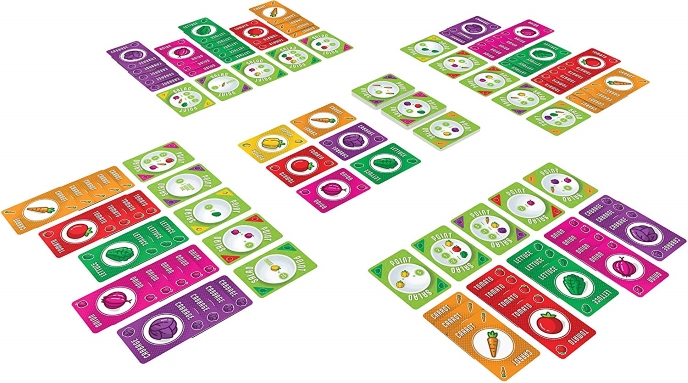
In the vernacular of the board gaming world, “point salad” is a derogatory term for games that encourage you to get small amounts of points from lots of different methods that don’t have much obvious connection to each other. Some point salad-y games are good, like The Castles of Burgundy or Tokaido, but most are kind of tiresome, like Merlin (same designer as Burgundy) or some of Uwe Rosenberg’s more involved games, like A Feast for Odin. To me, a point salad scoring system can either mean lazy design—here, do all the things, we’ll give you points no matter what, and don’t worry about long-range strategy—or a lack of editing, where someone might tell the designer to pull back on the reins.
So when the game called Point Salad showed up at my house a few weeks ago, my immediate reaction was “oh hell no,” figuring this might be a game that was proud of its salady nature. It’s not, though—that’s strictly the theme, and a very jocular wink in the direction of overly complex games with wordy rulebooks written by the ghost of Leo Tolstoy. Point Salad is actually a very light, fast-moving card-drafting game that we find incredibly fun and easy to teach to new players, with huge replay value because of the nature of the design itself.
Point Salad is played with a single deck that you’ll scale to the number of players—18 cards per player, up to the full deck of 108 if you play with six. The deck comprises an equal number of cards for each of the game’s six vegetables, and you’ll keep that equilibrium if you strip the deck down to play with fewer than six (e.g., nine cards of each vegetable for a three-player game). Each card is double-sided, with the vegetable on one side and some kind of point-scoring value on the other side.
You’ll split the deck into three piles, and then draw the top two cards from each to create a 2×3 tableau of vegetable cards from which players can choose. The piles are then placed above the columns, with their point side facing up. On your turn, you can either take any two vegetables from the grid (they don’t have to be in the same column), or you can take a single point card from the top of any pile. If you take a vegetable card, it stays that way for the remainder of the game. If you take a point card, you may flip it to its vegetable side at any time then or later on, but you can’t flip it back afterwards.

The point cards are the heart of Point Salad because there’s so much variety in them, forcing players to try to grab point cards that work together and to tailor their strategies around the point cards they acquired early in the game. Many reward you for certain combinations of vegetables—for example, five points for each pair of carrot/cabbage cards, or eight points for each triplet of lettuce/onion/tomato cards—while others give you points for one vegetable but deduct points for each card you have of another one. There are also quirky cards that give you a bonus if you have the most or the fewest cards of a vegetable (out of all players), or give you points for gathering all six, or give you three points for every vegetable of which you have at least two cards, and so on. There’s so much diversity in the cards that you should have some chance to gather three to four cards that work in concert, or at least don’t work overtly against each other.
The cards move and flip so frequently that you can’t always get what you want—although in my experience, you do indeed sometimes get what you need. You can certainly end up fighting over specific vegetable cards in a two-player game, but with more players there are enough cards of each vegetable type that you’ll usually be able to get at least two of the kind you’re collecting. The diversity of scoring methods feels extremely well balanced; you can definitely do more with the triplet cards, as hitting one of those bonuses four times gets you more than halfway to a winning score, but there are a few paths to victory and, since everyone will try to get some of those eight point cards, you’ll have to mix in a few other point cards as well.
Games take as little as ten minutes for two players and is extremely quick to learn; if you get to play with someone who’s played before, the best way to learn the game is to just play it, as the rhythm of the scoring is much easier to pick up through practice rather than through reading the rulebook (which is very short anyway). The game says it’s for ages 14 and up, but younger players who are good at arithmetic could probably handle this without trouble—it’s just a lot of multiplying, nothing more, and the number of potential moves you have on a turn is always limited by the small tableau of cards. If you’re looking for a good, light game you can play with kids or just with adults (and drinks), this one has plenty of fiber to keep you full.
Keith Law is a senior baseball writer for ESPN.com and an analyst on ESPN’s Baseball Tonight. You can read his baseball content at search.espn.go.com/keith-law and his personal blog the dish, covering games, literature, and more, at meadowparty.com/blog.